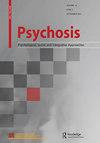Do voice-hearing assessment measures capture the positive experiences of individuals, and to what extent? A systematic review of published assessment measures
IF 1
4区 医学
Q4 PSYCHIATRY
Psychosis-Psychological Social and Integrative Approaches
Pub Date : 2021-07-05
DOI:10.1080/17522439.2021.1924242
引用次数: 1
Abstract
ABSTRACT Background Many individuals have positive experiences of voice-hearing (VH). However, current assessment tools do not capture positive aspects of VH as comprehensively as they do negative aspects. This may limit assessment and formulation of VH when people seek support from mental health services. Our review question was therefore:- ‘Do voice-hearing assessment measures capture the positive experiences of individuals, and to what extent?’ Method We conducted a systematic review of assessment measures which included at least one item on VH. We developed a novel framework to define “positive VH experiences”, which was co-produced by clinical experts in psychosis and people with VH experiences. This framework was then used to identify and map items relating to positive aspects of VH. Results Thirty-three measures were identified, of which twenty incorporated positive VH experiences. Measures published within the last decade (2009-2019) captured a greater number and diversity of positive VH experiences, compared to measures published prior to 2009. Items relating to the function/intention of voices and the emotional impact, were most commonly identified. Discussion Results suggest that research perceptions around VH are broadening and the nuances of experiences are increasingly considered alongside everyday and positive psychological functioning. Implications for both services and voice-hearers are discussed in the paper.语音听力评估措施是否捕捉到了个人的积极体验,以及在多大程度上?对已公布的评估措施进行系统审查
摘要背景许多人都有积极的听觉体验。然而,目前的评估工具并没有像捕捉负面方面那样全面地捕捉VH的积极方面。当人们寻求心理健康服务的支持时,这可能会限制VH的评估和制定。因此,我们的审查问题是:“声音听力评估措施是否捕捉到了个人的积极经历,以及在多大程度上?”方法我们对评估措施进行了系统回顾,其中至少包括一项VH。我们开发了一个新的框架来定义“积极的VH经历”,该框架由精神病临床专家和有VH经历的人共同制定。然后使用该框架来识别和绘制与VH积极方面相关的项目。结果确定了33项措施,其中20项纳入了积极的VH经验。与2009年之前发布的措施相比,过去十年(2009-2019年)发布的措施捕捉到了更多积极的VH体验,且具有多样性。最常见的是与声音的功能/意图和情感影响有关的项目。讨论结果表明,围绕VH的研究认知正在扩大,体验的细微差别越来越多地与日常和积极的心理功能一起被考虑。本文讨论了对服务和语音听话者的启示。
本文章由计算机程序翻译,如有差异,请以英文原文为准。
求助全文
约1分钟内获得全文
求助全文
来源期刊
CiteScore
2.20
自引率
8.30%
发文量
36

 求助内容:
求助内容: 应助结果提醒方式:
应助结果提醒方式:


